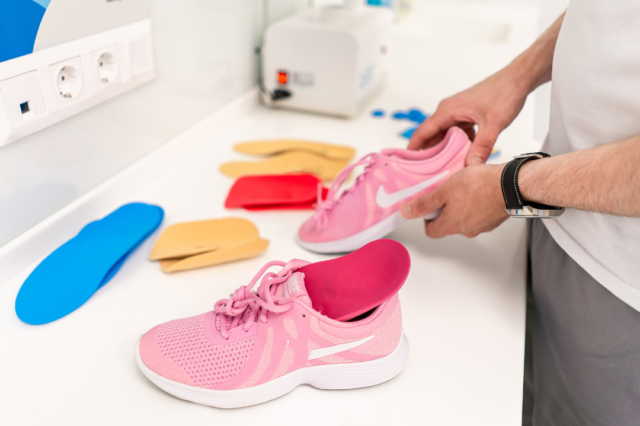
Author: Hanan Kane


Buying School Shoes Online? How To Measure Kids Feet Accurately
There’s not much time left before the new school year begins, so for our podiatrists, it’s the time where we find ourselves offering a lot of advice to parents around buying kids school shoes. Now traditionally, advice on buying school shoes focuses on making the purchase at a physical store and includes things like:
- Ensure you try both shoes on together and check the fit of both, as one foot is often slightly longer than the other
- Try shoes on in the afternoon rather than in the morning due to the natural swelling that can occur during the day
- And so on…
But the reality of a post-COVID era is that for time and convenience reasons (as well as health and safety), many more families are choosing to make their school shoe purchases online. So to help, we thought we’d share some tips on how to measure your children’s feet accurately and how to help get the best fit for your online shoe purchases.
1. Print The Brand’s Sizing Chart, If Available
Most brands will have a printable sizing chart available – just like this one from Bobux. If you can locate it online (it may be on the brand’s page as opposed to a particular store’s page) then print it out and make sure that ‘Page Scaling’ on your printer is set to ‘None’ and not ‘Fit to Printable Area’. Once printed, use a ruler to make sure it’s correct. Then place the chart on a flat, hard floor and place your child’s heel level with the baseline.
Make sure your child is standing with both feet taking even weight and always measure both feet. You want to record the size of the biggest foot and the tip of the largest toe – this isn’t always the big toe, it may be the second toe. For school-aged kids, you want to allow approximately 2cm for growth.
The reason we love a sizing chart is that we’ve found that some brands have a notable sizing difference and given how quickly children’s feet can grow, you really want to get the right size. And save yourself the hassle of a return or exhange.
2. Ruler Or Tape Measure
If no printable sizing chart is available and the site only offers measurements in centimetres, place one side of your ruler or measuring tape against a wall that is connected to a hard, flat surface (not carpet). Place your child’s heel against the wall so that it is gently touching. You can then level another flat object – like a piece of paper, a book, another ruler or something similar against the end of the longest toe, whichever that is, and read where it intersects with the ruler.
If the above doesn’t work, you can always make a mark on the floor (even with something easily erasable like a highlighter) and then take the measurement from that point. Again, allow a further 2cm for future growth, and select the appropriate size.
3. Assess The Shoe Type
Next, when coming to make that online purchase, look out for school shoes that are:
- Leather – we prefer leather for its many benefits, which include stretching to grow with your child’s feet for that little bit longer
- Have laces or velcro – having good fastening mechanisms means you get the longest lifespan out of your shoes by adjusting the fastening mechanism as they grow. It also means that the shoe is secured to the foot properly so the foot doesn’t have to forcefully grip at the base of the shoe for support and control, but can just relax. Buckles come after laces and velcro but are still superior to slip-ons.
- Aren’t too heavy – children take thousands of steps in their school shoes every day, day after day. This means that the weight can definitely add up and either help them stay healthy, happy and pain-free on their feet – or it can lead to those frustrating aches and pains at the end of the day. Opt for lightweight shoes, especially when muscles and muscle strength are still developing.
- Choose watertight materials where possible – good materials to help keep feet dry include synthetic leather, neoprene, rubber, and gore-tex, to name a few. For natural leather, you can use products like waterproofing oils, sprays and creams and wax products, as directed on the label.
4. Read The Reviews
Traditionally, when offering shoe fitting and purchasing advice, we’d promote checking the level of the support that the shoe can offer – in the arch, the heel counter and more. As you’re not able to do this online, we recommend reading the reviews, which can be found across a range of websites that stock the particular shoe style you’re looking at purchasing. Check what other parents have said and whether they recommend this shoe style. One of the things we do is to filter the reviews and remove the 4-star and 5-star reviews, so you’re just left with the lower-star rankings. If multiple people have complained about the shoes’ tendency to break apart or lead to aches and pains, take this into consideration when making your decision.
5. Arrival Check
Once your shoes have arrived, it’s time to check if they’re the right fit. We recommend our usual in-person set of tips, which include:
- Trying them on in the afternoon to account for natural foot swelling
- Wearing them with the winter socks your child will wear to school that year, to see if they will still fit well with thicker socks
- Check both the width and length
- Check there is still approximately a thumbs width for growth – always evaluate all aspects in both shoes equally
- Ensure it feels comfy and your child is happy
If your child has any foot pain or problems that are preventing them from running, walking or wearing their shoes comfortably, we’re here to help. Book an appointment with our trusted podiatrists by calling 09 523 2333 or book online here.

Choosing The Right Expert: Why A Podiatrist Is Your Best Bet For Foot And Ankle Pain
Foot and ankle pain can not only be debilitating, but also affects both our mobility and our overall quality of life. When faced with these issues, seeking the right professional expertise is crucial for accurate diagnosis, effective treatment – and getting back to feeling and moving well, as quickly as possible. In the realm of foot and ankle health, your podiatrist is your go-to foot and ankle expert. Here’s why.
Understanding The Role Of A Podiatrist
A podiatrist is a medical professional who specialises in the diagnosis, treatment, and prevention of conditions related to the feet, ankles and also the lower limbs. Their extensive training equips them to handle a broad spectrum of issues, ranging from common concerns like ingrown toenails to complex biomechanical problems influencing gait and posture including Achilles tendon pain, heel pain, shin splints, leg length differences and much more.
Why Choose A Podiatrist For Foot And Ankle Pain?
There’s a wide range of reasons that a podiatrist is the right health professional to see for your lower limb pain. These include:
They’re Experts In Foot Anatomy and Function
Podiatrists undergo extensive training focused specifically on the anatomy and function of the feet and ankles, as well as the lower limbs. Their in-depth knowledge allows for accurate diagnosis and targeted treatment plans tailored to address the unique challenges posed by this intricate area of the body.
Specialised Diagnostic Skills
Podiatrists possess specialised diagnostic skills honed through years of training and clinical experience. From identifying structural abnormalities to pinpointing the source of pain, their expertise ensures a thorough assessment of foot and ankle issues.
Comprehensive Treatment Options
Podiatrists offer a wide range of treatment options, including conservative measures, devices like braces, physical therapy, and minor surgical interventions when necessary. This comprehensive approach allows for the right, personalised care based on the nature and severity of a specific condition.
Management Of Chronic Conditions As Well As Acute Injuries
Chronic conditions such as arthritis, diabetes-related foot complications, and neuropathy require ongoing management. Podiatrists are well-equipped to provide continuous care, helping patients navigate the challenges associated with these persistent issues.
Biomechanical Expertise
Many cases of foot and ankle pain stem from biomechanical issues affecting gait and posture. Podiatrists specialise in assessing and addressing these concerns, utilising orthotics, exercises, and other interventions to restore proper biomechanical function.
Preventative Care
Beyond treating existing issues, podiatrists emphasise preventive care. Regular check-ups with a podiatrist can identify potential problems early on, allowing for proactive measures to prevent the development or progression of foot and ankle conditions.
Evidence-Based Practice
Podiatric medicine is grounded in evidence-based practice, with treatment approaches informed by the latest research and clinical guidelines. This commitment to evidence ensures that patients receive care based on proven methods and advancements in the field.
Podiatrists vs Physiotherapists
While physiotherapists play a crucial role in rehabilitation and overall musculoskeletal health, the specialised focus of podiatrists on the feet and ankles sets them apart in the context of foot and ankle pain.
Specifically, physiotherapists tend to have a broader focus on the entire musculoskeletal system, addressing issues related to muscles, joints, and movement patterns. Podiatrists, on the other hand, concentrate specifically on the lower extremities, making them more specialised in the intricacies of foot and ankle conditions. This enables podiatrists to provide more targeted interventions for foot and ankle pain, leveraging their focused skillset to address conditions ranging from toenail problems to complex biomechanical issues.
Podiatrists are also trained in both conservative and surgical interventions for foot and ankle conditions, where physiotherapists are not, being unable to perform procedures like permanent ingrown toenail correction surgery. This means that in cases where surgery is required, podiatrists can seamlessly transition from diagnosis to treatment.

Caring for Ageing Feet: How Your Podiatrist Helps

As we get older, certain tasks get that little bit harder – whether it’s getting your shoes on, opening a jar, or reaching your feet to trim your toenails. This is why skin and nail care is a very important part of what we do here as podiatrists. Taking care of ageing feet goes beyond maintaining comfort; it contributes to mobility, balance, and the enjoyment of an active lifestyle. Whether we’re reducing the thickness of your nails, removing corns, or managing cracked heels, we know that by relieving your pain and improving your comfort, we’re directly helping you to keep moving on your feet, so you can optimise your health.
Here’s a look at the ways that our team here at Perform Podiatry helps to manage and maintain the foot health of older adults.
Footwear Assessment, Advice and Modifications
Your shoes become the ground you walk on, being responsible for supporting your comfort, stability and mobility. We work closely with older adults to ensure that their shoes are helping them through every step and not hindering them, and give personalised advice based on any foot conditions or ailments you have – from foot pain to bunions and more.
Generally speaking, you want to opt for shoes that provide ample support, cushioning, and a proper fit. Ill-fitting shoes can lead to discomfort, blisters, and even foot deformities. Look for shoes with a wide toe box and adjustable fasteners to accommodate potential foot swelling.
Keeping Toenails Trimmed
When your toenails are properly trimmed and maintained, it reduces your risk of ingrown toenails and related infections. Podiatrists can also reduce the thickness of your toenails, improving both your comfort and their appearance. If managing toenails at home, you want to trim them straight across and avoid cutting them too short to prevent discomfort.
Managing Corns And Calluses
Like with toenails, regular podiatry appointments help you stay on top of any corns and calluses that arise, meaning you get to walk comfortably and without pain. It is not recommended to attempt to manage these at home due to the risks in older feet.
Providing A ‘Second Eye’
While it’s one thing to advise older adults to regularly check their feet for signs of deterioration, redness, sores, blisters, cuts or anything else that’s sinister, it’s very different to be able to do it, especially with vision changes and greater difficulty reaching the feet. Your podiatrist acts as a ‘second eye’ at every skin and nail care appointment, catching potential issues early that may have been missed which can prevent them from escalating into more serious complications.
Addressing Dry Skin
Ageing skin tends to become drier, and this applies to the feet as well. Your podiatrist can help with dry skin as well as complications such as cracks in the heels, helping promote your comfort and reducing the risk of infection. If managing dry skin at home, applying a moisturiser, especially to the heels, can prevent cracking and discomfort. Avoid applying lotion between the toes, as it can create a moist environment conducive to fungal growth.
Monitoring Foot Sensation
Loss of sensation in the feet is another common issue among older adults, which can lead to unnoticed injuries. This is something that you can discuss with your podiatrist at your appointment, and something they can help you monitor and manage. At home, regularly check for numbness, tingling, or changes in sensation and consult a healthcare provider if such issues arise.
Preventing Falls
A person’s fall risk can be reduced by 36% when working with a podiatrist. With approximately one third of all falls being preventable in nature, many people are choosing to work proactively with their podiatrist in areas such as falls risk assessments, footwear checks, custom foot orthotics, balance assessments and more to help reduce their falls risk and improve their long-term health and comfort.
If your feet or legs are causing you pain or discomfort, or you’ve found that over the years you are no longer able to care for them in the best way, then our Perform Podiatry team here in Remuera, Auckland, are here to help. We’re proud to help thousands of people every year look after their foot health. We’d love for you to join us.
Book your appointment by calling us on 09 523 2333 or book online here.
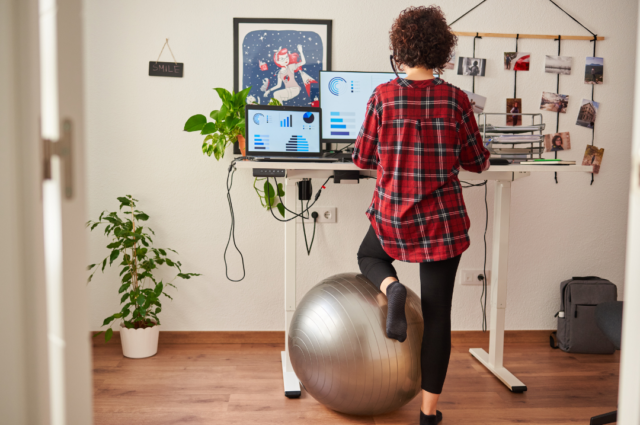
Does Your Leg And Foot Posture At Your Desk Really Matter?
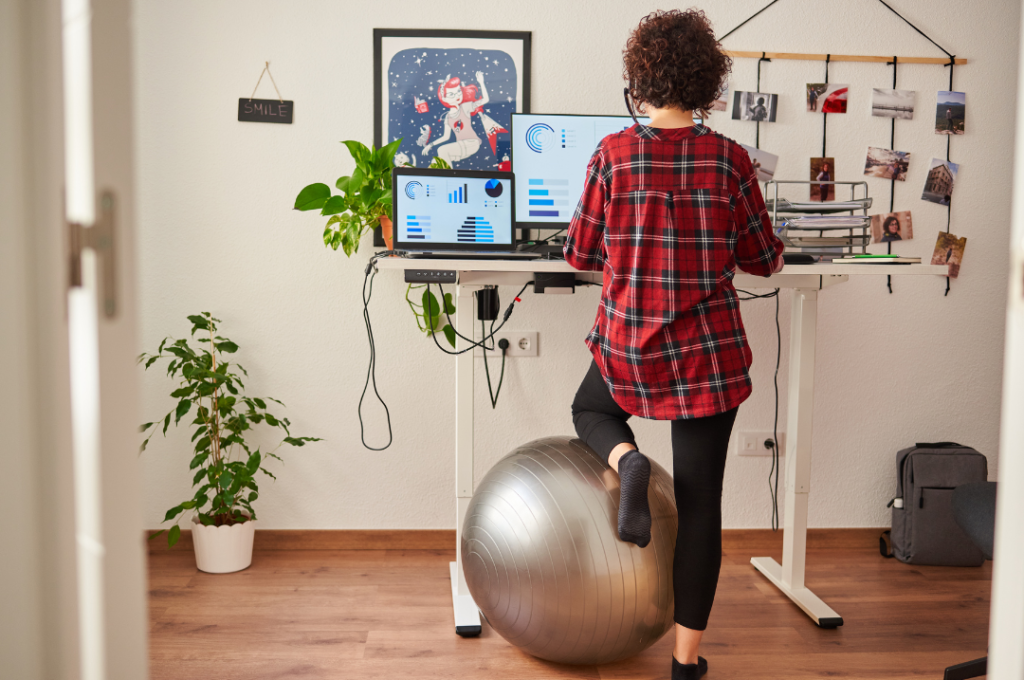
Whether you’re in the office or working remotely, a lot of our workforce spends a significant portion of their day sitting at a desk, often in front of a computer. While sitting may seem natural and harmless, poor posture has the potential to lead to various health issues, including discomfort, pain, and musculoskeletal problems that require professional care. Yes, the way you position your hips, legs, and feet when sitting on a chair can significantly impact your overall well-being. Here’s How.
The Consequences of Poor Posture
Your Hips
There are two main elements of poor posture when it comes to the hips. Sitting with a slouched hip posture, where the hips are rolled backwards, can lead to excessive pressure on the lumbar spine. This position places extra strain on the lower back muscles, potentially causing lower back pain and discomfort. Sitting with elevated hips, where your hips are higher than the knees due to an inadequate chair height can result in pressure on your hip flexors. Over time, this can lead to tightness and discomfort in these muscles.
Your Legs
Sitting with your legs crossed can restrict blood flow and lead to numbness and tingling in the legs. It may also place uneven pressure on the knees, potentially contributing to knee pain and long-term joint issues. Similarly, keeping your legs extended straight under the desk can hinder blood circulation, causing discomfort and potentially contributing to varicose veins over time.
Your Feet
Allowing your feet to dangle without proper support can result in lower back pain and poor circulation in the legs. This posture may also lead to the development of varicose veins. Tucking your feet under the chair can also create unnecessary pressure on the knees and lead to discomfort over time.
So How Should You Be Sitting?
Aim to:
- Sit with your hips in a neutral position, where the natural curve of the lower spine is maintained. This minimises the stress on the lower back and helps prevent pain and discomfort.
- Use a chair with lumbar support, as it can help maintain the natural curve of your lower back and provide additional comfort.
- Ideally, keep your hips and knees at a 90-degree angle to one another when sitting. Adjust the chair height so that your feet are flat on the floor, promoting proper circulation and reducing stress on the knees.
- Avoid crossing your legs, instead keep both feet flat on the ground or on a footrest to prevent pressure on the knees and ensure optimal blood flow.
- Use a footrest, as it can help support your feet and maintain proper posture while reducing the risk of lower back pain.
- Ensure that your feet are not tucked under the chair. Instead, keep them flat on the ground or on a footrest.
Experiencing Pain In Your Feet Or Legs?
If you’re experiencing pain in your feet or legs, whether that’s related to your lower limb posture or from something else – we’d love to help. Give our podiatry team a call. We’re based in Remuera, in the One Health medical building, close to Newmarket. Call us on 09 523 2333 or book online here.

NZ Skiing and Snowboarding: Injury Prevention Tips From Your Podiatrist

Snow sports like skiing and snowboarding can be thrilling, even here in New Zealand. Whether you’re planning a trip down to Queenstown this season or making the most of the (potential) last season at our North Island ski fields, it’s important to spend at least a little time preparing your body to minimise the risk of injuries and enhance your performance on the slopes – especially if you’re planning to spend a week at the mountain.
Cardiovascular Work
Snow sports demand stamina and endurance, making cardiovascular fitness vital. Despite relying on gravity for downhill momentum, skiers often encounter flat areas that require skiing or pushing along. Snowboarders may need to remove their boards and walk on flat terrain, which can quickly become tiring due to the added weight of gear. Building cardiovascular fitness through regular aerobic exercise, such as running or cycling, can enhance endurance and help you navigate these challenges with ease. Try to add a few extra sessions weekly in the month leading up to your trip (or longer if you can!).
Strengthening Work
Both skiers and snowboarders rely on specific muscle groups while on the mountain. Skiers require strong core muscles to stabilise their spine, pelvis, hamstrings and quads for knee bending and leg extension, lower leg muscles for foot control and ski edging, and glutes for overall stability. Snowboarders, on the other hand, heavily engage the quads, hamstrings, and glutes while maintaining knee flexion, with the calves playing a crucial role in maintaining balance and controlling ankle movement. Additionally, upper body strength is essential for skiers who use ski poles and for snowboarders who need to manoeuvre and re-strap their boards. This means getting in a few extra weekly gym sessions in the month leading up to your ski trip to help your body prepare best.
Flexibility Work
Snow sports really put your joints to the test, making flexibility crucial for preventing injuries and helping you have a safe ski holiday for the whole family. We recommend incorporating a thorough stretching program before your ski holiday to enhance your joint strength and mobility. Prioritise consistency over session length, stretching frequently for shorter durations. Ensure you stretch through the full range of motion, feeling the stretch at the end points. On ski days, warm up your body and stretch your muscles properly to reduce the risk of injury, as cold muscles are more susceptible to strains.
Provide Extra Support To Vulnerable Areas
If you have any pre-existing injuries, niggles, or weak areas, it’s essential to provide them with additional support to prevent exacerbation on the slopes. Consider using strapping, compression gear, or knee guards if necessary. Seeking advice from a podiatrist can help you determine the best ways to protect vulnerable areas and prevent potential injuries. They can guide you on proper strapping techniques and injury prevention measures tailored to your specific needs.
Listen to Your Body
Listening to your body is crucial both before and during your snow sports adventure. Pain and discomfort should never be ignored, as they are often signs of an underlying issue. If you experience pain or niggles before your trip, it’s important to address them to avoid further complications. Likewise, if something feels off during your time on the slopes, pay attention to your body’s signals and take appropriate action. Ignoring warning signs can lead to more severe injuries and prolonged pain.
Frequently Asked Questions
Can foot pain affect my performance while skiing or snowboarding?
Yes, foot pain can significantly impact your performance and overall enjoyment of snow sports. Proper ski footwear, foot support, and addressing any underlying foot conditions are crucial for optimal performance.
Should I wear custom orthotics while skiing or snowboarding?
If you use custom orthotics in your daily life, you may consider using orthotics that are fitted especially for your ski or snowboard boots – but this may only apply in some cases and you should consult your podiatrist. While custom orthotics can provide additional support, improve alignment, and help alleviate foot pain, standard orthotics don’t tend to fit into already tight-fitting ski and snowboard boots, and the skiers we work with usually have custom ski orthotics made if they’re heading to the slopes regularly.
What type of socks should I wear for snow sports?
Choose moisture-wicking socks made from synthetic or wool materials to keep your feet dry and warm. Avoid cotton socks as they retain moisture and can lead to discomfort and blisters.
How can I prevent blisters while skiing or snowboarding?
To prevent blisters, wear well-fitted boots or shoes that provide ample room for your toes. Consider using blister pads or applying moleskin to areas prone to friction. Ensure your socks are clean and dry before putting them on. We also have a range of silicone toe props and other products available from the clinic for you to try.
How do I choose the right ski or snowboard boots?
Unfortunately, the only answer to this is to consult with a professional boot fitter who can assess your foot shape, size, and specific needs to help you find the right boots, as individual needs vary so greatly from person to person.
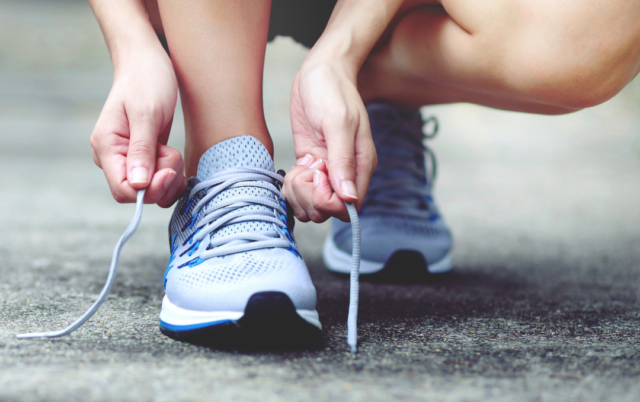
Best Footwear For Foot Pain
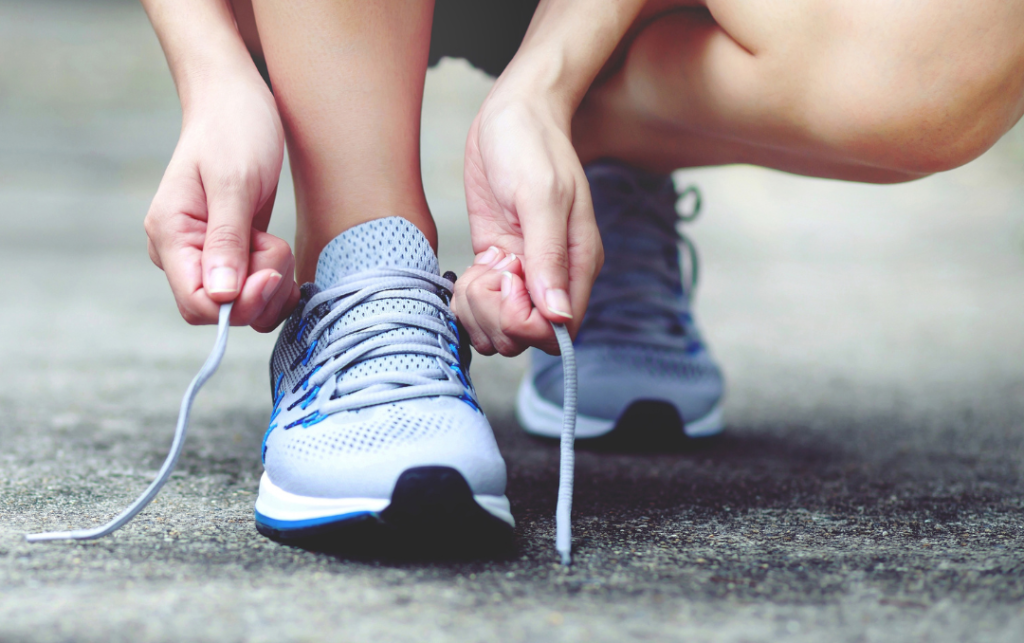
Dealing with foot pain is a challenging and uncomfortable experience for most. Whether you’re suffering from plantar fasciitis, arthritis, a foot or ankle injury, or any other foot condition, take it from the pros: wearing the right footwear can make a significant difference in alleviating your discomfort, reducing your recovery time, and promoting proper foot health to see you through a lifetime. But what should you look for in good shoes?
Sports Shoes With Good Support
Athletic shoes that are engineered for specific activities, such as running or walking, can provide excellent support, stability and offloading (via good cushioning) for those with foot pain. Look for shoes that have a supportive midsole, ample arch support, and a cushioned insole. These features help absorb shock, reduce strain on the feet, and promote a stable gait. Additionally, sports shoes often come in a variety of widths, ensuring a good fit for individuals with different foot shapes and sizes, including a spacious toe box.
Low-Heeled Shoes
When your foot pain is primarily present at the forefoot, it’s best to avoid high heels and opt for low-heeled shoes instead. Higher heels place excessive pressure on the forefoot and can exacerbate conditions like metatarsalgia and pains around the ball of the foot. Low-heeled shoes with a heel height of approximately 2cm provide better stability, reducing strain on the feet and promoting a more natural gait. Again, look for low-heeled shoes with cushioned insoles for shock absorption,good arch support, stability around the ankle, and a spacious toe box.
Sandals with Arch Support
During warmer months or casual occasions, if you need to wear sandals, we recommend selecting sandals with built-in arch support to help offer comfort and support for foot pain relief. Look for sandals with contoured footbeds that provide adequate arch support – or better yet, sandals with removable footbeds so you can slot your own custom foot orthotics in. Having adjustable straps helps to ensure a secure fit and allows for individual customisation. Avoid flat sandals with minimal cushioning, as they provide little to no support and can exacerbate foot pain.
Orthopaedic Shoes
While traditionally orthopaedic shoes had a bad wrap due to their ‘unfashionable’ or bulky appearance, today orthopaedic shoes have actually come a long way and there’s a much wider option range that many of our patients are loving. The benefits of orthopaedic shoes are their very specific designs that are made to provide support, stability and cushioning for a range of foot conditions. They often also come with additional arch support, extra padding, wider toe boxes and several other features that help them stand out from standard shoes when you’re experiencing notable pain or discomfort. The arch support helps distribute weight evenly, reducing pressure on specific areas of the foot. The added cushioning offers shock absorption, minimising impact on joints. Orthopaedic shoes also provide ample room for the toes, preventing constriction and allowing natural movement.
What About Custom Foot Orthotics?
Custom foot orthotics are specially designed shoe inserts that are moulded to match the unique contours of your feet. These inserts can provide targeted support and stability, relieving foot pain caused by most podiatric conditions – from flat feet or high arches to plantar fasciitis or shin splints. Custom orthotics help improve foot alignment, redistribute pressure, and reduce strain on specific areas of the foot. They can be used in various types of shoes, including athletic shoes, casual footwear, and even dress shoes.
Footwear To Avoid
Just like choosing good, supportive footwear, it is also crucial to be mindful of footwear choices that can worsen your foot pain and leave you feeling worse for longer. Avoid shoes with unsupportive soles, thin insoles, or minimal cushioning, as they offer little shock absorption and can exacerbate your discomfort. Additionally, narrow or pointy-toed shoes can compress the toes, worsening conditions like metatarsalgia, bunions or corns. Shoes that do not provide proper arch support can contribute to improper foot alignment and increase strain on certain areas.
Frequently Asked Questions
Can I wear my regular flats and office shoes if I’m experiencing foot pain?
It’s best to avoid unsupportive shoes if you’re experiencing foot pain, including your work shoes. If you must wear your work shoes at work, consider consulting with a podiatrist about whether orthotics could be a suitable option for your work shoes. Invest in footwear specifically designed to provide support, cushioning, and stability for your feet.
Are there specific brands known for foot-friendly shoes?
Several brands specialise in creating footwear for foot pain relief, such as Dr Comfort, Brooks, New Balance, Birkenstock, and Vionic. However, it’s essential to find shoes that suit your individual needs and foot condition. Your podiatrist can provide you with advice on particular styles that may work best for you.
Can I use orthotics in any type of shoe?
Custom orthotics can be used in a wide range of shoe types, as long as they have removable insoles. However, it’s advisable to choose shoes with ample space to accommodate the orthotics comfortably. Never try to cram orthotics in if your shoes aren’t designed to accommodate orthotics.
How often should I replace my shoes when I have foot pain?
When you’re experiencing foot pain, you don’t necessarily need to replace your shoes more often than normal, but you do need to make sure you’re following the guidelines for replacing your shoes. For shoes that you wear on a daily basis or get decent mileage on, this means replacing them every 800-1000kms, or every six months. If they have significant signs of wear or break down they may need to be changed sooner.
Can I wear high heels occasionally if I have foot pain?
As health professionals, we recommend avoiding high heels, even on an occasional basis, as they can significantly strain the feet and worsen your existing foot pain. If you must wear them, do so for as little time as possible – which may look like wearing good comfortable shoes in the car and stepping out in your heels for as little time as possible.
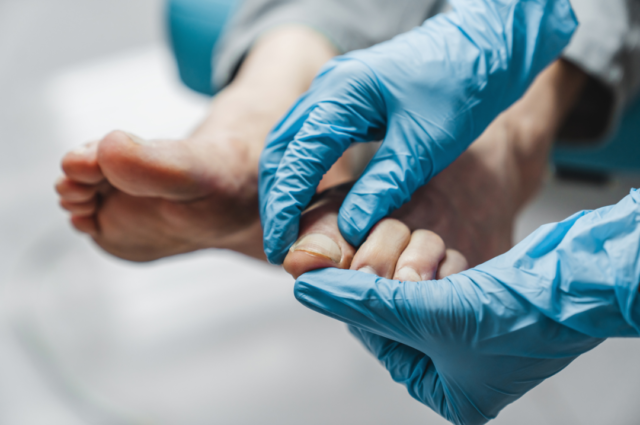
Signs Your Ingrown Toenail Needs Help From Your Podiatrist
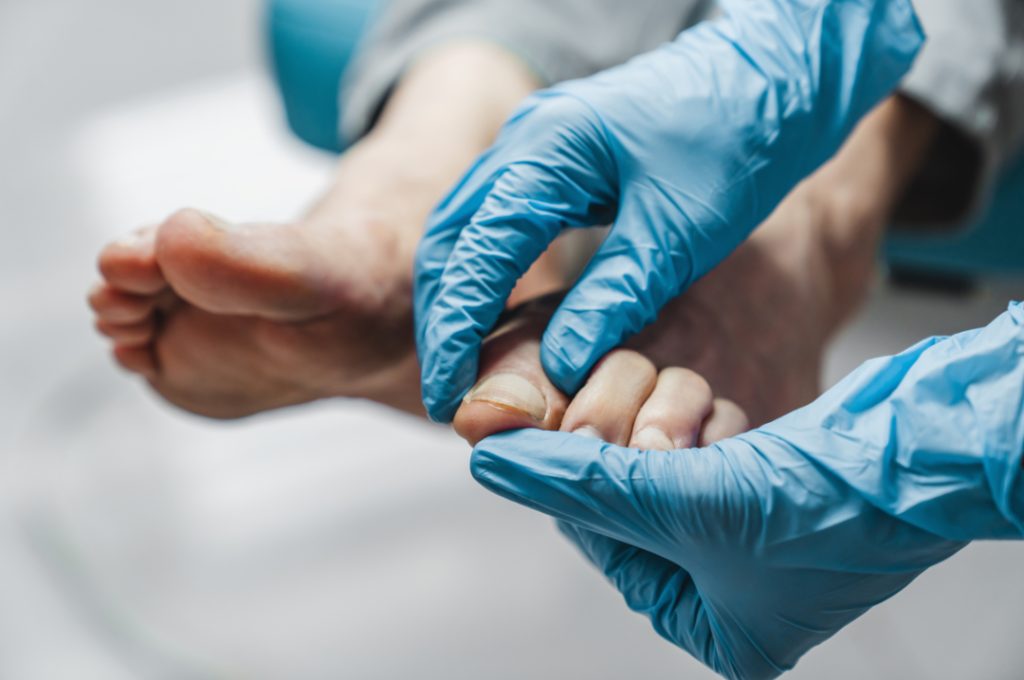
If you consider ingrown toenails to be the most debilitatingly painful problem given that it involves such a seemingly small nail, you’re not alone. These are the exact same thoughts shared by most people who come into our ingrown toenail clinic to have their ingrown nails professionally cared for – and often to get rid of them for good. But how do you know if your ingrown nail is fine to manage at home, or if you should come in for professional treatment?
Ingrown Toenail: The Basics
First thing first: an ingrown toenail occurs when the edge of a toenail grows into the surrounding skin rather than over it. Think of a small but sharp dagger piercing through healthy skin and staying embedded there – it’s actually very similar! This can result in pain, redness, swelling, and potential infection. Ingrown toenails most commonly affect the big toe, but any toe can be affected.
Identifying An Ingrown Toenail
To spot an ingrown toenail, look for:
- Pain and discomfort: one of the earliest signs is tenderness or pain along the edge of the affected toenail. Ingrown toenails can also affect both edges of the same toenail.
- Redness and swelling: the skin around the ingrown toenail may become red, swollen, and painful to the touch.
- Inflammation: as your ingrown toenail grows deeper into the surrounding skin, you may notice the surrounding area become red and inflamed. Sometimes, there may be pus or clear fluid leaking from the area, which may also be a sign of infection.
- Difficulty wearing shoes: ingrown toenails can make wearing shoes uncomfortable, and pressure from footwear may worsen the condition.
- Overlapping skin: you may see the edge of the nail curling into the surrounding skin or observe overlapping of the skin onto the nail.
Home Care For Mild Cases
If your ingrown toenail is mild, you may try managing your symptoms at home by:
- Soaking your feet in warm, soapy water for 15-20 minutes, 2-3 times a day. This can help soften the nail and reduce inflammation.
- After soaking, use a clean, disinfected tool, such as a dental floss pick, to gently lift the ingrown edge of the nail away from the skin. Do not force it. This should be easy if the ingrown nail is mild so that it is only pressing against the side of the skin as opposed to already growing deep inside. If the nail has already significantly pierced into the skin, it’s time to see a podiatrist.
- Continue to keep the area clean and dry, avoiding tight footwear that puts pressure on the toe.
- You can try to place a sterile bandage or a piece of cotton under the lifted nail edge to encourage it to grow above the skin. Again, this will not be suitable if your nail has already notably pierced into the skin.
When To Get Help For Your Ingrown Nail
While home care can help with mild cases, you should consult a podiatrist if you experience the following:
- If ingrown toenails repeatedly affect the same toenail, a professional evaluation is essential to address the root cause.
- If there are signs of infection, such as increasing redness, pus, or discharge, it’s crucial to book in with your podiatrist
- Those with diabetes or circulation problems should not attempt self-treatment for ingrown toenails. These conditions can lead to complications and delayed wound healing.
- A painful abscess (collection of pus) or the presence of a draining sinus warrants immediate attention.
- If your symptoms worsen or fail to improve within a few days of home care, consult a podiatrist.
Final Tip
Ingrown toenails can be simple for a health professional to manage – but only if they have the right tools, experience and knowledge. As a clinic that sees ingrown toenails day in and day out, we have refined our protocols and processes to ensure you get the very best care for your ingrown nail every time.
Each person’s treatment plan is uniquely tailored to their symptoms and circumstances to help you get the best long-term results. Our podiatrists take the time to discuss every step of the process, alongside all of your treatment options, and are here to help you or your child have the very best experience with their toenail treatment. We’re based in Remuera, in the One Health medical building, close to Newmarket. Call us on 09 523 2333 or book online here.

Podiatry Tips For Protecting Your Feet This Winter
Raynaud’s Phenomenon
The first condition we tend to see is called “Raynaud’s phenomenon” or syndrome. Raynaud’s affects both the feet and hands, and it is triggered by cool temperatures. If you experience Raynaud’s, you’ll notice that certain parts of your feet, particularly the toes, turn stark white, resulting in patchy discolouration. Other areas may turn red or blue or purple, and you may also feel extreme coldness and numbness in your feet. Raynaud’s occurs when the blood vessels in your feet constrict, limiting blood flow. Interestingly, stress can also contribute to the onset of Raynaud’s symptoms. As normal blood flow returns, you may experience sensations of heat, tingling, throbbing, or swelling in your feet. What can you do? The key is to keep your feet warm and dry. When your feet are warm, the blood vessels widen, promoting circulation and preventing episodes of Raynaud’s.Dry, Cracked Skin
Did you know that the soles of your feet lack oil glands? This means that they are prone to drying out, especially in colder temperatures. Dry skin reduces sensitivity in our feet and makes us more susceptible to calluses and cracks, particularly on the heels. What can you do? The solution is simple: moisturise daily. Regularly applying moisturiser is crucial since your feet cannot naturally keep the skin moist. You don’t need expensive skincare products; your regular moisturiser will suffice to keep your skin smooth, supple, and healthy. If you notice a significant callus build-up, consider having it reduced by your podiatrist. The same applies to any cracks that form in the heels.Fungal Nail And Skin Infections
Fungus thrives in warm, moist, and dark environments—just like the conditions found in our enclosed winter shoes and warmer socks. Spending all day in these environments, combined with increased rainfall and foot sweating, creates the perfect breeding ground for fungal infections. However, fungal infections don’t simply materialise; you must come into contact with fungal spores. Whether it’s at a friend’s house, your local gym, or a swimming pool, if you pick up the infection, there’s a higher chance it will spread faster than in summer when going barefoot or wearing sandals allows your feet to dry out. What can you do? After every shower or when removing your shoes, thoroughly dry your feet. If your shoes get wet, let them dry completely before wearing them again, and ensure your feet are dry too. Wash and dry your socks thoroughly, paying attention to the spaces between your toes. Consider using sprays or powders on your feet or in your shoes to maintain a dry environment and discourage fungal growth. If you notice signs of a fungal nail infection (discoloration or patches on your toenails) or athlete’s foot (bubbles in the skin, dryness, itchiness, or redness), seek treatment from a podiatrist who can provide the appropriate antifungal care. The earlier you address a fungal infection, the easier it is to treat and eliminate.Ingrown Toenails
Colder temperatures often mean thicker socks, which, combined with snug-fitting shoes, leave less room for your feet. As your toenails grow, they may press against the skin due to the restricted space, significantly increasing the risk of developing ingrown toenails. What can you do? Keep your nails trimmed straight across the nail, avoiding cutting into the sides. If your toes feel uncomfortable and cramped in thick socks, opt for thinner socks made from warm and durable materials like merino.Amplified Effects Of Diabetes On The Feet (Sensation And Blood Flow)
For individuals with diabetes, the impact on nerves and blood vessels gradually diminishes sensation and circulation in the feet. Colder temperatures can amplify these effects, similar to what occurs in Raynaud’s phenomenon. Consequently, it is crucial to diligently monitor your feet during this time, ensuring you don’t sustain any unnoticed cuts or wounds that could lead to infection. What can you do? Make it a habit to check your feet daily, examining both the top and bottom. If necessary, use a mirror to inspect the bottom of your feet. Keep your feet protected and warm at all times, even indoors by wearing socks and slippers. Avoid exposing your feet to direct heat, such as open fires or hot water bottles, as decreased sensation may prevent you from feeling potential burns. Regularly moisturise your feet to maximise your sensation. Additionally, ensure you have your annual diabetic foot health check to stay informed about your foot health status and understand the specific precautions you should take.Need Help Caring For Your Feet?
Our experienced podiatry team is here to help, and leave you feeling great on your feet. Book your appointment online here or call us on 09 523 2333